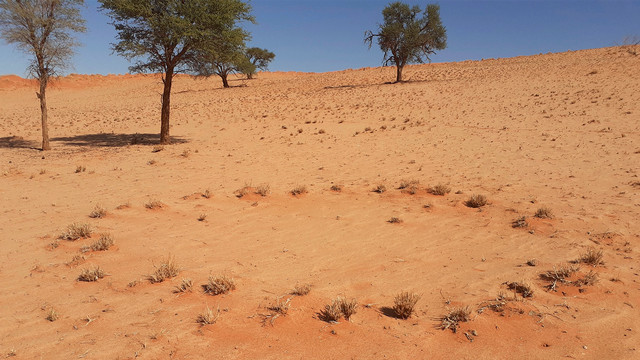What’s Really Happening Beneath Namibia’s Fairy Circles?
New Research
Fairy circles are one of the world’s great natural puzzles. A new study by University of Richmond biology professor Amy Treonis shows they’re more than just pretty patterns — they’re living laboratories for how ecosystems self-organize. The study spans nine field sites across approximately 900 km of the Namib Desert and is the only study on soil nematode communities linked to fairy circles. Treonis explains how unseen soil organisms can influence landscape patterns.
What exactly are fairy circles?
Dr. Amy Treonis: They’re mysterious, round patches of bare soil surrounded by rings of grass, found across Namibia’s deserts. From the air, they look like polka dots stretching for miles. Scientists have debated for decades whether they’re caused by termites, plants competing for water, or something else.
What new angle does this research bring?
Most studies look at the plants and soil chemistry related to fairy circles. This study zooms in on soil nematodes — tiny worms that live underground and are crucial to soil health. It’s the first large-scale survey (covering 9 sites across nearly 900 km) to ask: how do these hidden organisms respond to fairy circles?
What did you find inside the circles? And what about the grassy rings?
The barren centers were nearly devoid of nematodes with no thriving soil community, just a few hardy bacteria-eaters. It’s a kind of biological desert within the desert. In contrast, the grass rings are a very different story. The soils under the grass and in the surrounding landscape were full of nematodes, especially plant parasites and fungal feeders. In other words, the living soil communities mirror the vegetation patterns we see aboveground.
Why does this research matter?
Our findings suggest the circles aren’t just empty on the surface; however, they’re sustained by what’s missing belowground. Without a functioning soil food web in the centers, plants can’t re-establish there, which may help lock in the pattern in place over time.
Does this solve the fairy circle mystery?
Not entirely, but it adds a crucial piece. Termites and plant water competition may still play roles, but now we know soil life itself helps reinforce the circles. It’s a striking example of how tiny, unseen organisms can shape entire landscapes.
